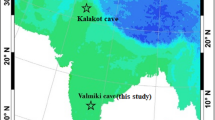Abstract
High resolution carbon isotopic records in millennial, centennial and decadal timescales from three stalagmites from three different caves under a similar monsoon climate in Guangxi–Guizhou, China, provided detailed information on the paleo-ecological environmental conditions in the past 15,000 years. The results indicate that during the glacial period, or cold-dry period, such as Heinrich event H1 and Younger Dryas event karst development was poor as was pedogenesis, C3 vegetation didn’t grow well, resulting in C4 plants dominating and with heavy δ13C values in stalagmites. In a warm-humid stage, C3 vegetation grew well and predominated with negative δ13C values. The δ13C records from stalagmites could be indicative of sensitive vegetation changes and reflective of climate changes in precipitation, temperature, etc. The δ13C records may also be used to distinguish different effects from nature or human activity. Particularly since the late Holocene, human activities have increased disturbances to environment, even more than natural factors. Forest vegetation was destroyed, C4 plants became dominant, and rock desertification was aggravated because of severe water and soil loss, all resulting in sharply increasing δ13C values of stalagmites that are heavier than pre-middle Holocene δ13C values.




Similar content being viewed by others
References
Boutton TW (1991) Stable carbon isotope ratios of natural materials, II atmospheric, terrestrial, marine, and freshwater environments. In: Coleman DC, Fry B (eds) Carbon Isotope Techniques. Academic, San Diego, pp 173–185
Brook GA, Burney DA, Cowart JB (1990) Desert palaeonvironmental data from cave speleothem with examples from the Chihuahuan, Somali-Chalabi, and Kalahari deserts. Palaeogeogr Palaeoclimatol Palaeoecol 76:239–311
Denniston RF, Gonzalez LA, Asmerom Y (2000) Speleothem carbon isotopic records of Holocence environments in the Ozark Higlands, USA. Quat Int 67:21–27
Dorale J A, Edwards R L, Ito E (1998) Climate and vegetation history of the midcontinent from 75 to 25 ka: a speleothem record from Crevice Cave, Missouri, USA. Science 282:1871–1874
He SY, Xu SY, Zhang ML (1997) Observation on soil CO2 concentration, hydrochemistry, and their relationship with karst processes. Carsologica Sinica 16(4):319–324
Hendy CH (1971) The isotopic geochemistry of speleothem-Pt, I the calculation of the effects of different model of formation on the isotopic composition of speleothems and their applicability as paleoclimate indicators. Geochim Cosmochim Acta 35:801–824
Li HC, Gu DL, Chen WJ, Li TY(1998) Application of high-resolution carbon isotope record of a stalagmite from the Shihua Cave, Beijing—13C record of deforestation after the establishment of the grand capital (Yuan Dadu) in 1272 A.D. Geol Rev 44(5):456–463
Quade J, Cerling TE, Bowman JR (1989) Development of the Asian monsoon revealed by marked ecologic shift in the latest Miocene of northern Pakistan. Nature 342:117–119
Wang GA, Han JM (2001) δ13C Variations of C3 plants in dry and rainy seasons. Mar Geol Quat Geol 21(4):43–47
Yuan DX, Liu ZH, Jiang ZC, Qin JM, Cao JH, Zhang ML, Li B, He SY et al (2003) Carbon cycle and karst geology environment. Science publishing house, Beijing, China, pp 95–175
Yuan DX, Cheng H, Edwards RL, Dykoski C A, Kelly M J, Zhang ML, Qin JM, Lin YS et al (2004) Timing, duration, and transitions of the last interglacial asian monsoon. Science 304:575–578
Zhang ML, Cheng H, Lin YS, Qin JM, Zhang HL, Tu LL, Wang H, Feng YM (2004a) High resolution paleoclimatic environment records from a stalagmite of Dongge Cave since 15000a in Libo, Guizhou Province, China. Geochimica 33(1):65–74
Zhang ML, Yuan DX, Lin YS, Qin JM, Li B, Cheng H, Edwards RL (2004b) A 6000-year high-resolution climatic record from a stalagmite in Xiangshui Cave, Guilin, China. Holocene 14(5):697–702
Acknowledgments
This work was supported by two National Science Foundations of China grants (Grant No. 90511004 and 40231008). We thank Professor Ian J. Fairchild (University of Birmingham) and Dr. Malcolm S. Field (National Center for Environmental Assessment, U.S.) for reviewing this manuscript. And we thank researchers for their efforts.
Author information
Authors and Affiliations
Corresponding author
Rights and permissions
About this article
Cite this article
Zhu, X., Zhang, M., Lin, Y. et al. Carbon isotopic records from stalagmites and the signification of paleo-ecological environment in the area of Guangxi—Guizhou, China. Environ Geol 51, 267–273 (2006). https://doi.org/10.1007/s00254-006-0324-z
Received:
Accepted:
Published:
Issue Date:
DOI: https://doi.org/10.1007/s00254-006-0324-z




